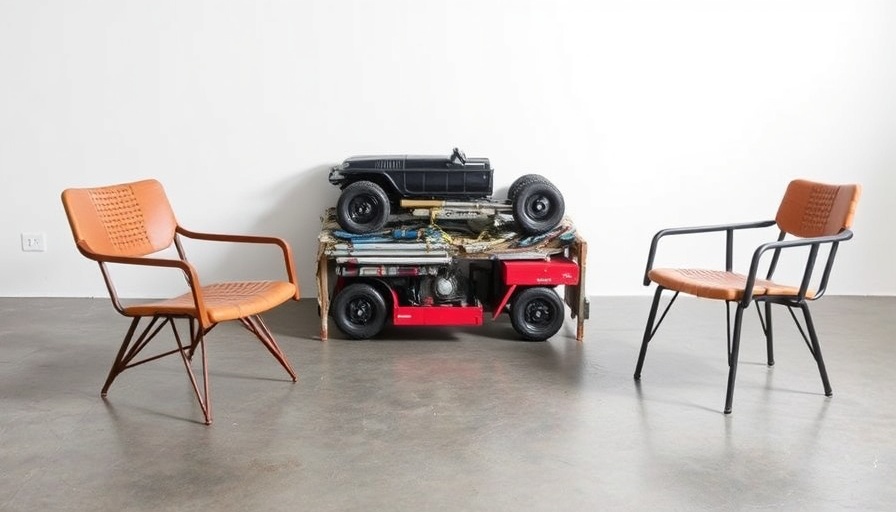
Revolutionizing Workspace Design: MSCHF's Innovative Furniture Collection
In an unprecedented fusion of automotive design and furniture innovation, the art collective MSCHF has launched a striking collection that reimaginatively repurposes parts from Mercedes-AMG cars into unique furniture pieces. Showcased during NYCxDesign, this collection not only elevates the conversation around design but also opens new avenues for remote workspaces, especially for digital nomads seeking comfort and efficiency.
Unveiling the MSCHF x Mercedes-AMG Collection
The MSCHF x Mercedes-AMG collection consists of eleven inventive pieces, including a couch with headlights functioning as armrests and a quirky trash can that features actual car pedals. Each item, cleverly integrating automotive elements, aims to spark joy and creativity in everyday life. For digital nomads who often prioritize both functionality and aesthetic in their remote workspaces, these designs offer a novel way to infuse personality into an otherwise utilitarian environment.
Where Ergonomics Meets Artistry
MSCHF took inspiration from a visit to the AMG headquarters in Germany, where they immersed themselves in the aesthetic of stripped-down vehicles. Kevin Wiesner, co-chief creative officer of MSCHF, emphasized the playful approach of the collection: "We wanted a balance of furniture types... but also to prioritize the physical actions we had the most fun with when we were playing with the pieces." This statement aligns with the principles of ergonomics, highlighting the importance of comfort and joy in design.
Design that Functions
Many of the collection's pieces serve functional purposes that are especially advantageous for remote work. For instance, a standout item—a chair made from three car headrests—uses a framework of bright yellow pipes, providing both comfort and a conversation starter. Such unique design elements can enhance the ambiance of a workspace, making it as much about expression as it is about utility. Using parts that symbolize speed and performance, the collection challenges traditional furniture norms while catering to comfort needs.
Exploring Contextualization in Design
Importantly, MSCHF's collection seeks to investigate the idea of "contextualization or misuse" rather than literal recycling. By taking elements typically reserved for luxury automobiles and translating them into everyday objects, there’s a layered significance in their use. Understanding how automotive materials can translate into comfort-oriented designs could inspire digital nomads to rethink how and where they invest in their workspaces.
Practical Insights for Remote Workers
As digital nomads frequently adapt their environments for maximum productivity, incorporating artisanal yet functional pieces can create a stimulating atmosphere that fosters creativity. Here are a few practical tips inspired by the MSCHF collection for creating a home workspace that aligns with both aesthetic sensibilities and ergonomic safety:
- Choice of Furniture: Select multifunctional pieces, like the MSCHF’s loveseat that also features working headlights. Such furniture can serve as both a statement piece and a practical solution for various tasks.
- Incorporate Playfulness: Embrace designs that evoke joy. A lighthearted twist, such as a light that uses a seatbelt mechanism to turn on, can brighten your workspace and enhance mood.
- Customize Your Decor: Utilize found objects or repurposed materials in your workspace to add personality. This mirrors the creative rigor imbued in the MSCHF collection.
Conclusion: Embrace Innovation in Your Work Environment
The MSCHF x Mercedes-AMG collection is on view at 62 Bayard St, Brooklyn, NY from May 15 to 17, 2025. For digital nomads looking to create distinct and effective work environments, this ingenious collection serves as a template for blending creativity with functionality. As you curate your workspace, take inspiration from MSCHF’s innovative approaches and don’t hesitate to incorporate playful, ergonomic designs into your daily life. Embrace the future of workspace design by redefining what furniture can represent and how it can elevate your work-from-home experience.
 Add Row
Add Row  Add
Add 




Write A Comment